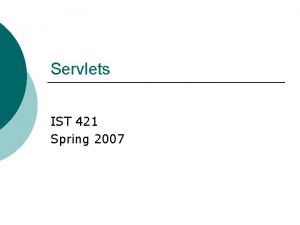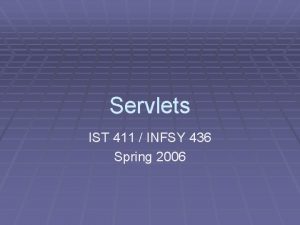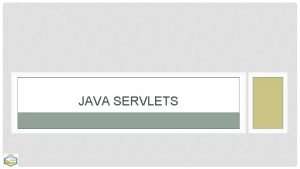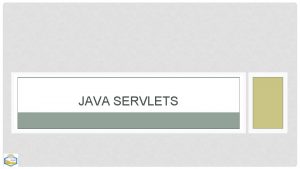Servlets IST 411 Lecture 5 Spring 2004 Servlets













- Slides: 13

Servlets IST 411 Lecture 5 Spring 2004

Servlets § Java servlets are server-side applications § Are multi-threaded and can share resources § Since they are compiled, provide better performance than scripting interpreters like Perl § Do not have the security restrictions of applets

Servlet Technology § Supported directly by most browsers § All servlets must invoke the Servlet interface: § Javax. servlet – in the servlet. jar libraries

Servlet Lifecycle Creation Init Service § § § Destroy Servlet container loads servlet into memory init ( ) is invoked by the container After init ( ) is complete, the servlet can respond to requests § service ( ) receives requests, processes them, and responds to the client. § § Method is called one time/request Each new request invokes a new thread § destroy ( ) releases resources

Abstract classes § Generic. Servlet from javax. servlet § Http. Servlet from javax. servlet. http § Most servlets extend one or the other of the above and override some of their methods § WEB servlets usually extend Http. Servlet

Servlet Methods § void init (Servlet. Config config) § Automatically called to initialize the servlet § The argument is supplied by the servlet container that executes the init servlet § Servlet. Config get. Servlet. Config ( ) § Returns a reference to an object that implements the Servlet. Config interface § The object provides configuration information and provides the servlet with access to its environment (i. e. the servlet container in which it executes)

Servlet Methods § String get. Servlet. Info ( ) § This method is defined by the programmer § Returns a string to servlet information such as the author and version § void service (Servlet. Request request, Servlet. Response response) § The servlet container calls this method to respond to a client request § Called once per request § void destroy ( ) § Cleanup method when servlet is destroyed

Http. Servlet § Defines processing for servlets that extend functionality of a WEB server. § In this class we will extend Http. Servlet § Key method in every servlet is service, first method called.

Http. Servlet § Common request types: § HTTP get to supply data as part of the request § Parameters are passed to a servlet as name/value pairs § Cache the data obtained for fast processing § Limit of 255 characters for its parameters § Request is in the form of a URL § Only character data may be sent § HTTP post to post data to a WEB server § Subtle difference – post normally will not cache the information § Most often method used to obtain form information § No limit to size of parameters § May carry character or binary data

Http. Servlet § The methods in Http. Servlet to accomplish these tasks are called by service: §do. Get §do. Post

Http. Servlet. Request and Http. Servlet. Response § Are arguments of do. Post and do. Get § These methods make it easy to access data

Let’s Practice

Servlet Projects: 1. Build a project in Eclipse 2. Include a class 3. Include the servlet. jar by: a. Right click on the project name b. Select Properties c. Select Java Build Path d. Select libraries e. Add External jars: Note: Here you must locate a file that is called servlet. jar and point to it. Normally it is included in the Tom. Cat 4. ncommon/lib. However, a search of the Tom. Cat structure should provide you with the location. f. The servlet. jar file is needed so that the system includes the set of servlet libraries necessary
 Ist 411
Ist 411 Ist 411
Ist 411 Ist 411
Ist 411 Servlets notes
Servlets notes Coreservlets
Coreservlets 01:640:244 lecture notes - lecture 15: plat, idah, farad
01:640:244 lecture notes - lecture 15: plat, idah, farad Summer autumn winter spring months
Summer autumn winter spring months Giduk
Giduk Ist spring design and validation
Ist spring design and validation Analysisist
Analysisist Zu glauben ist schwer. nichts zu glauben ist unmöglich
Zu glauben ist schwer. nichts zu glauben ist unmöglich Winter kommt winter kommt flocken fallen nieder
Winter kommt winter kommt flocken fallen nieder Klassendienst
Klassendienst Es ist herbst bunte blätter fliegen
Es ist herbst bunte blätter fliegen























